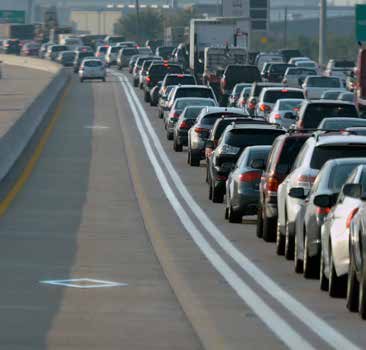Looking at Dynamic Carpooling Systems for El Paso
What's the Problem?
El Paso has traffic concerns similar to those in other metropolitan areas – high congestion at peak morning and afternoon times, expensive construction costs and the challenge to increase road capacity with existing space. In El Paso, these concerns are seen mainly along I-10, which connects the east and west sides of the city.
Carpooling could help mitigate these traffic issues, but drivers typically find carpooling inconvenient. Understanding how to make carpooling more convenient and desirable to drivers could be a solution for improving mobility in El Paso.
What's the Solution?
With dynamic (or express) carpooling, smart phone apps coordinate drivers’ schedules, taking the inconvenience out of carpooling. Knowing this, the Texas A&M Transportation Institute’s Center for International Intelligent Transportation Research team studied dynamic carpooling as a solution for metropolitan areas such as El Paso.
How the Study Was Done
After researching how other communities are implementing dynamic carpooling, the team surveyed 1,200 college students who attend The University of Texas—El Paso or one of the El Paso Community College’s campuses. The purpose of the survey was to determine the interest of having a solution such as dynamic carpooling.
Findings
The study showed that 40 percent of students overall and 51 percent of those who currently rely on transit systems are interested in trying out a dynamic carpooling system. The research also showed that an aggressive publicity campaign and targeted promotion would be integral to the success of dynamic carpooling.
Benefits
If a solution like dynamic carpooling is implemented, areas like El Paso could be one step closer to solving their congestion dilemma. Reducing the number of single-occupant vehicles on the road is key to better utilizing current roadway capacity without building and maintaining new lanes on existing roadways. By encouraging innovative capacity management strategies like dynamic carpooling, local communities can improve mobility while simultaneously saving drivers/taxpayers commuting time in the short run and money—that otherwise would’ve been spent on building and maintaining new lanes—over the long term.
Project Title
Design of an Express Carpooling System for the Border RegionProject Sponsor(s)
Center for International Intelligent Transportation Research
Project Category
Mobility
Project Publications
For More Information
Gabriel Alejandro Valdez
Associate Transportation ResearcherResearch and Implementation - El Paso
Texas A&M Transportation Institute
The Texas A&M University System
4050 Rio Bravo Dr., Suite 151
El Paso, TX 79902
Ph. (915) 532-3759
g-valdez@tti.tamu.edu
